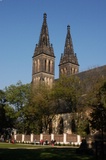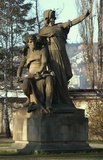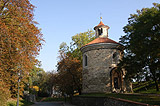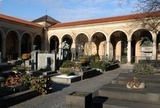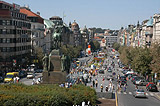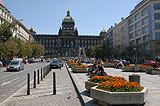Charles University in Prague
Aug 21, 13:34 Filed under history
 “Learning is like a jigsaw puzzle. When you first lay the pieces out, it doesn’t make much sense. When you start to connect the pieces, you then begin to see how it all fits together”. These words were said by an anonymous writer long time ago. But this person exactly described the meaning of the word education. When you say the words Charles University you will describe the word education as well as the author of the mentioned quotation.
“Learning is like a jigsaw puzzle. When you first lay the pieces out, it doesn’t make much sense. When you start to connect the pieces, you then begin to see how it all fits together”. These words were said by an anonymous writer long time ago. But this person exactly described the meaning of the word education. When you say the words Charles University you will describe the word education as well as the author of the mentioned quotation.
Charles University is a center of education in the Czech Republic. It is the oldest university in the Czech Republic and one of the oldest universities of the world. It was founded by the decision of The Church. In this case it was founded by the bull of Klement VI, certified in Avignon on 26 January in 1347.There were four faculties: the preparing faculty for liberal arts and continued faculties were the faculty of laws, medicin and theology. At The University there were four nations: The Czech, The Bavarian, The Saxon and The Polish.
In 1403 the teaching of John Wyclif was forbidden to distribute. In 1409 The King Václav IV. regulated the deciding powers of The Czech by The Kutnohorský decree. It had the effect that some professors left to the University in Leipzig.
Nowadays Charles University contains 17 faculties. Over 42,400 students study there and there are more than 4300 foreign students—750 of which study academic programs in English language.
Charles University aims to be recognized as a competitive research university on the world stage and stresses international cooperation with prestigious educational and scientific establishments. Charles University has entered into 450 bilateral contracts and 170 international partnerships with foreign universities.
 This famous bridge has just celebrated 650th birthday!! How cool is that! That is hell of a lot years, don’t you think? Just think about it: in 1357, English poet Geoffrey Chaucer was only 14 years old; the Hundred Years War between France and England was about to end in next 96 years; Columbus was about to discover America not sooner than 135 years later; Pilgrims celebrated their first Thanksgiving after long 264 years… Jeez, do you know any older bridge that serves thousands of pedestrians every day?
This famous bridge has just celebrated 650th birthday!! How cool is that! That is hell of a lot years, don’t you think? Just think about it: in 1357, English poet Geoffrey Chaucer was only 14 years old; the Hundred Years War between France and England was about to end in next 96 years; Columbus was about to discover America not sooner than 135 years later; Pilgrims celebrated their first Thanksgiving after long 264 years… Jeez, do you know any older bridge that serves thousands of pedestrians every day? In the Czech Republic, June 27 has been declared a day of remembrance in honor of the victims of communism. Why this day and not any other? Well, it is all related to the history and one exceptionally sad story of one incredibly strong woman.
In the Czech Republic, June 27 has been declared a day of remembrance in honor of the victims of communism. Why this day and not any other? Well, it is all related to the history and one exceptionally sad story of one incredibly strong woman. 
 Did you know that Albert Einstein himself was in Prague? The famous German-born American theoretical physicist widely regarded as the most important scientist of the 20th century and one of the greatest physicists of all time was walking the streets of Prague some 95 years ago! He did not only visit Prague, he actually worked here!
Did you know that Albert Einstein himself was in Prague? The famous German-born American theoretical physicist widely regarded as the most important scientist of the 20th century and one of the greatest physicists of all time was walking the streets of Prague some 95 years ago! He did not only visit Prague, he actually worked here! November 17 was the impulse for great changes to come. The six-week period between November 17 and December 29, 1989, that is the time period called the Velvet revolution. On December 29, Vaclav Havel, a dissident and a play writer well known for his anti-communist opinions, became the President of the Czechoslovakia. Soon enough, in June 1990, the first democratic elections since 1946 were held in Czechoslovakia.
November 17 was the impulse for great changes to come. The six-week period between November 17 and December 29, 1989, that is the time period called the Velvet revolution. On December 29, Vaclav Havel, a dissident and a play writer well known for his anti-communist opinions, became the President of the Czechoslovakia. Soon enough, in June 1990, the first democratic elections since 1946 were held in Czechoslovakia.  But why both events took place on November 17 and not on some other day? Well, both evens are connected. And I will tell you how.
But why both events took place on November 17 and not on some other day? Well, both evens are connected. And I will tell you how.  As you probably know, on the 28th of October Czechs celebrate a
As you probably know, on the 28th of October Czechs celebrate a 